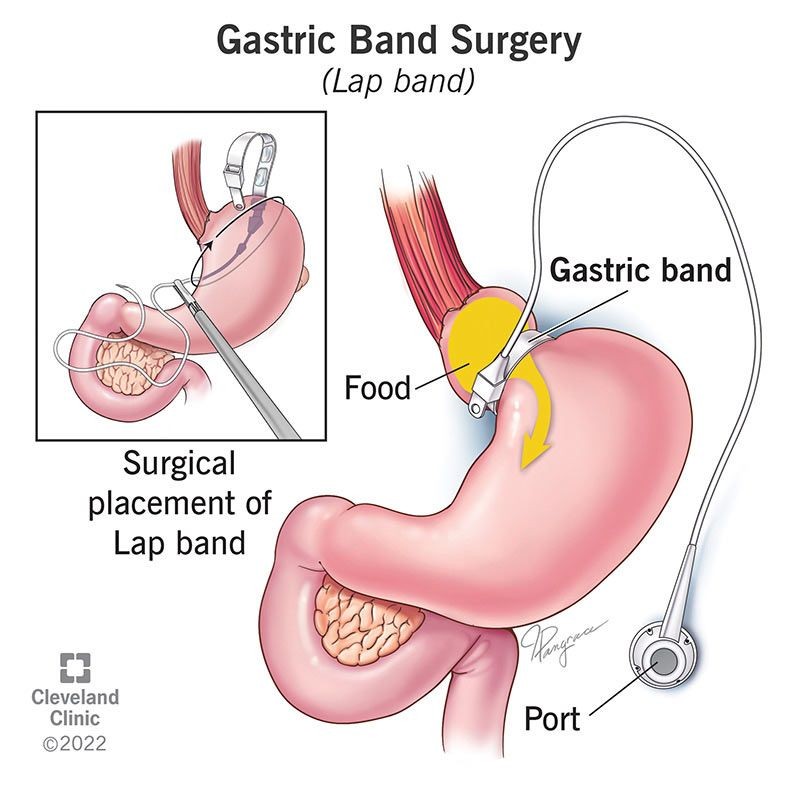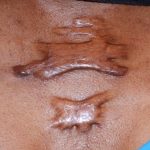
Contents
- 1 Lap Band Surgery (Gastric Banding)
- 1.0.1 What is gastric banding?
- 1.0.2 What is a lap band?
- 1.0.3 Who are candidates for the lap band system?
- 1.0.4 How is the lap band (LAGB) procedure performed?
- 1.0.5 How do I prepare for lap band surgery?
- 1.0.6 How long is the recovery after lap band surgery?
- 1.0.7 What is a lap band fill?
- 1.0.8 What can I expect my lifestyle to be after lap band surgery (LAGB)?
- 1.0.9 What are the side effects of lap band surgery (LAGB)?
- 1.0.10 What are the risks and complications of lap band surgery (LAGB)?
- 1.0.11 What type of surgeon performs lap band surgery (LAGB)?
Lap Band Surgery (Gastric Banding)
Side effects of lap band surgery include nausea, vomiting, ulceration at the band site, esophageal reflux (indigestion), weight regain, and dehydration.
Obesity is a growing concern. By medical standards, obesity is defined as having a body mass index (BMI) over 30 kg/m2. While lifestyle modification remains the cornerstone for treatment, surgical options are becoming more popular. One surgical treatment for obesity is gastric banding, also known as lap-band surgery. This article addresses some of the specifics of gastric banding.
What is gastric banding?
Laparoscopic adjustable gastric banding (LAGB) is a surgical procedure that involves placing an adjustable belt around the upper portion of the stomach using a laparoscope. The band is made of silicone and can be tightened by adding saline to fill the band. It restricts the size of the stomach, slows the passage of food to the intestine, and creates a sensation of fullness and satiety with less food. This signal is sent from a small pouch created by the band in the upper stomach.
What is a lap band?
The LAP BAND® is a specific brand name device made by Allergan Inc. It is often used interchangeably with gastric banding. Other companies make gastric banding devices such as the REALIZE® adjustable gastric band (by Ethicon), the MIDBAND®, and the Heliogast® gastric band.
Who are candidates for the lap band system?
Generally, candidates for LAGB have a BMI over 40 kg/m2 or are more than 45 kilograms over their ideal body weight. LAGB can also be performed on individuals with a BMI of 35-40 kg/m2 who have weight-related medical conditions like high blood pressure or diabetes. Most surgeons will want to note a history of failed weight loss with conventional approaches. The procedure is indicated for adults only and is not performed on those under 18 years old. All patients must demonstrate an understanding of the procedure and be willing to make lifestyle changes for success. Psychological assessment is often required to ensure this criterion is met.
LAGB is usually contraindicated if the potential patient has difficulty understanding the procedure, is emotionally unstable, or is dependent on drugs or alcohol. Those with a history of gastrointestinal problems or underlying medical conditions that make them high risk for surgery may also be refused the procedure. In this group, there may be a request to lose weight before the procedure. However, dropping the BMI under 50 kg/m2 may improve outcomes.
While there is growing discussion about offering LAGB to those with a BMI of 30-35 who have diabetes, there are no current guidelines for this.
How is the lap band (LAGB) procedure performed?
Lap band or LAGB is a surgical procedure done under full general anesthesia and takes about 1 to 2 hours. It is done using a laparoscopic technique. The surgeon makes small incisions, inserts a camera into one of the incisions, and views the procedure on a screen. The band is placed around the upper part of the stomach and set in position with sutures. A port is placed in the abdomen wall for adjustments.
How do I prepare for lap band surgery?
Preparation for surgery varies. Many centers like to see a commitment from the patient to the necessary lifestyle changes even before surgery. It may be suggested to start eating 5 to 6 small meals a day and weaning off high-calorie foods like ice cream or milkshakes that are easily absorbed. Medical risk reduction may be needed preoperatively for those with high BMI or other medical issues. Weight loss of 5% to 10% before surgery may improve outcomes.
How long is the recovery after lap band surgery?
Recovery varies, but LAGB offers a shorter hospitalization and quicker recovery than gastric bypass procedures. Most people can return to work 1 week after surgery. Normal activity can usually resume after 6 weeks.
What is a lap band fill?
A lap band "fill" is a gastric band adjustment. It usually takes place around 6 to 8 weeks after surgery. Saline is injected into the port connected to the band to enhance weight loss or overcome side effects like nausea and vomiting.
What can I expect my lifestyle to be after lap band surgery (LAGB)?
After surgery, there will be some pain and discomfort that can be controlled with medication. Weight loss with LAGB is gradual. The food choices made will govern the weight loss rate. The average weight loss is 40% of excess body weight in the first year. Patients are usually asked to keep in contact with their surgeon regularly as further band adjustments may be needed.
What are the side effects of lap band surgery (LAGB)?
Side effects include nausea, vomiting, ulceration at the band site, esophageal reflux, weight regain, and dehydration. Vitamin deficiencies are not usually seen since this surgery does not cause nutrient malabsorption. Constipation is commonly encountered.
What are the risks and complications of lap band surgery (LAGB)?
LAGB has a low risk of surgical complications compared to other weight reduction procedures. The mortality rate is about 1 in 2000. There is a possibility of the band slipping or eroding into the stomach and mechanical malfunction. Other complications may include infection, bleeding, and abdominal pain.
What type of surgeon performs lap band surgery (LAGB)?
When choosing a surgeon, it is important to search for one who is a qualified bariatric surgeon. A surgeon performing 100 or more procedures annually is likely to have better outcomes. A surgeon who is part of a clinical team can provide better counseling and support in the pre and postoperative period.
By clicking Submit, I agree to the MedicineNet’s Terms & Conditions & Privacy Policy and understand that I may opt out of MedicineNet’s subscriptions at any time.
References:
Dixon JB., O’Brien PE. Changes in comorbidities and improvements in quality of life after LAP-BAND placement. The American Journal of Surgery, December; Vol 184: pp S51-S54.
Favretti F., Ashton D., Busetto L., Segato G., De Luca M. The Gastric Band: First-Choice Procedure for Obesity Surgery. World Journal of Surgery, October; Vol 33(10): pp 2039-48.
Ren CJ., Horgan S., Ponce J. US experience with the LAP-BAND system. The American Journal of Surgery. December; 184(6B): pp 46S-50S.


